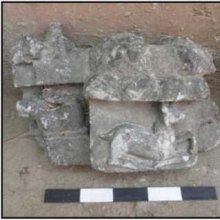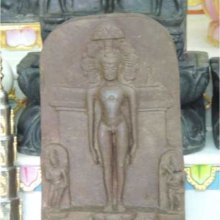Sambhavanatha, Saṃbhavanātha, Sambhavanātha, Sambhava-natha: 3 definitions
Introduction:
Sambhavanatha means something in Jainism, Prakrit. If you want to know the exact meaning, history, etymology or English translation of this term then check out the descriptions on this page. Add your comment or reference to a book if you want to contribute to this summary article.
Images (photo gallery)
In Jainism
General definition (in Jainism)
Source: Wisdom Library: JainismSambhavanātha (सम्भवनाथ) is another name for Sambhava, the third Tīrthaṅkara (Janism recognizes 24 such teachers or Siddhas). His name can also be spelled as Sambhavanātha (सम्भवनाथ). His colour is gold (kāñcana), according to Aparājitapṛcchā (221.5-7). His height is 400 dhanuṣa (a single dhanuṣa (or, ‘bow’) equals 6 ft), thus, roughly corresponding to 732 meters. His emblem, or symbol, is an Horse.
Sambhavanātha’s father is Jitari and his mother is Senā according to Śvetāmbara but Suṣeṇā according to Digambara. It is an ancient Jain practice to worship the Tīrthaṅkara’s parents in various rites, such as the pratiṣṭhāvidhi, according to the Ācāradinakara (14th century work on Jain conduct written by Vardhamāna Sūri).
Source: archive.org: The Jaina IconographySambhavanātha (सम्भवनाथ) refers to the third of twenty-four Tīrthaṃkaras or Jinas, commonly depicted in Jaina iconography.—The Jaina literature relating to our subject provides the distinct clue to identify the image of Sambhavanātha. That clue is the symbol of horse (Turaya Skt. Turaga) connected with his representations. We are informed from the same literature of his Yakṣa being Trimukha and Yakṣiṇī being Duritārī Devī—other special marks of his images. The tree under which Sambhavanātha received the Kevala knowledge and of which the mention is made in the Jaina books is the Indian Śāla tree (Sharia robusta)—his bearer is called Satyavīrya.
The Jina’s parentage has come down to our knowledge through Jaina history. His father was a king named Dṛḍharāja and his mother was called Suṣeṇā. His birth place is Śrāvasti. The king, his father, hadbeen distressed to see the way his dominions were ravaged by plague, but when he heard the good news of the boy’s birth, hefelt there was a chance (Sambhava) of better times coming, hence the boy’s name.
The Jina’s symbol of horse, which in India is regarded as auspicious originates from the idea of good chance associated with his name. His Yaksa’s emblem of a mongoose Skt. Sarvatobhadra (lucky on all sides), and the Yakṣiṇī’s name as Duritāri, meaning “vanquisher of enemies” and her symbols of Varada-mudrā, fruit and Abhaya all very clearly bespeak the same idea of auspiciousness or “good chance”.
Source: academia.edu: Tessitori Collection ISaṃbhavanātha (संभवनाथ) or Saṃbhavanāthagīta refers to one of the twenty-four songs (gīta) embedded in the Caturviṃśatijinagīta by Jinarāja (dealing with classical hymns and stotras from Jain literature), which is included in the collection of manuscripts at the ‘Vincenzo Joppi’ library, collected by Luigi Pio Tessitori during his visit to Rajasthan between 1914 and 1919.

Jainism is an Indian religion of Dharma whose doctrine revolves around harmlessness (ahimsa) towards every living being. The two major branches (Digambara and Svetambara) of Jainism stimulate self-control (or, shramana, ‘self-reliance’) and spiritual development through a path of peace for the soul to progess to the ultimate goal.
See also (Relevant definitions)
Partial matches: Natha, Shambhava.
Starts with: Sambhavanathagita, Sambhavanathastavana.
Full-text: Shala, Shambhava, Satyavirya, Sushena, Dridharaja, Trimukha, Khadgasana, Prajnapti, Sarvatobhadra, Shravasti, Duritari.
Relevant text
Search found 3 books and stories containing Sambhavanatha, Saṃbhavanātha, Sambhavanātha, Sambhava-natha, Sambhava-nātha, Saṃbhava-nātha; (plurals include: Sambhavanathas, Saṃbhavanāthas, Sambhavanāthas, nathas, nāthas). You can also click to the full overview containing English textual excerpts. Below are direct links for the most relevant articles:
Jain Remains of Ancient Bengal (by Shubha Majumder)
Images of Tīrthaṅkara Saṃbhavanātha < [Chapter 6 - Iconographic Study of Jaina Sculptural Remains]
The twenty-four Tīrthaṅkaras and their Yakṣas and Yakṣiṇīs < [Chapter 6 - Iconographic Study of Jaina Sculptural Remains]
Meaning of Tīrthaṅkara < [Chapter 1 - Introduction and Scope of the Present Study]
A study of the philosophy of Jainism (by Deepa Baruah)
Chapter I.c - The lives of the Tīrthaṅkaras < [Chapter I - Introduction]
Jainism in Odisha (Orissa) (by Ashis Ranjan Sahoo)
Iconography of Jain Gods and Goddess < [Chapter 6]
Iconography of Tirthankaras < [Chapter 6]

